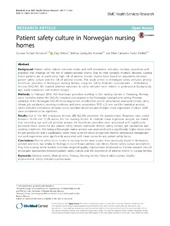| dc.description.abstract | Background: Patient safety culture concerns leader and staff interaction, attitudes, routines, awareness and practices that impinge on the risk of patient-adverse events. Due to their complex multiple diseases, nursing home patients are at particularly high risk of adverse events. Studies have found an association between patient safety culture and the risk of adverse events. This study aimed to investigate safety attitudes among healthcare providers in Norwegian nursing homes, using the Safety Attitudes Questionnaire – Ambulatory Version (SAQ-AV). We studied whether variations in safety attitudes were related to professional background, age, work experience and mother tongue. Methods: In February 2016, 463 healthcare providers working in five nursing homes in Tønsberg, Norway, were invited to answer the SAQ-AV, translated and adapted to the Norwegian nursing home setting. Previous validation of the Norwegian SAQ-AV for nursing homes identified five patient safety factors: teamwork climate, safety climate, job satisfaction, working conditions and stress recognition. SPSS v.22 was used for statistical analysis, which included estimations of mean values, standard deviations and multiple linear regressions. P-values <0.05 were considered to be significant. Results: Out of the 463 employees invited, 288 (62.2%) answered the questionnaire. Response rates varied between 56.9% and 72.2% across the five nursing homes. In multiple linear regression analysis, we found that increasing age and job position among the healthcare providers were associated with significantly increased mean scores for the patient safety factors teamwork climate, safety climate, job satisfaction and working conditions. Not being a Norwegian native speaker was associated with a significantly higher mean score for job satisfaction and a significantly lower mean score for stress recognition. Neither professional background nor work experience were significantly associated with mean scores for any patient safety factor. Conclusions: Patient safety factor scores in nursing homes were poorer than previously found in Norwegian general practices, but similar to findings in out-of-hours primary care clinics. Patient safety culture assessment may help nursing home leaders to initiate targeted quality improvement interventions. Further research should investigate associations between patient safety culture and the occurrence of adverse events in nursing homes. | en_US |

